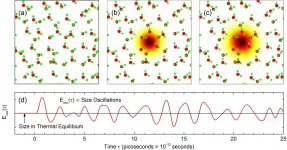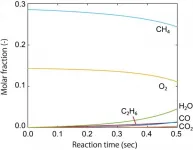(Press-News.org) Nairobi/Paris, 4 March 2021 - An estimated 931 million tonnes of food, or 17% of total food available to consumers in 2019, went into the waste bins of households, retailers, restaurants and other food services, according to new UN research conducted to support global efforts to halve food waste by 2030.
The weight roughly equals that of 23 million fully-loaded 40-tonne trucks -- enough bumper-to-bumper to circle the Earth 7 times.
The Food Waste Index Report 2021, from the United Nations Environment Programme (UNEP) and partner organization WRAP, looks at food waste that occurs in retail outlets, restaurants and homes - counting both food and inedible parts like bones and shells. The report presents the most comprehensive food waste data collection, analysis and modelling to date, and offers a methodology for countries to measure food waste. 152 food waste data points were identified in 54 countries.
The report finds that in nearly every country that has measured food waste, it was substantial, regardless of income level. It shows that most of this waste comes from households, which discard 11% of the total food available at the consumption stage of the supply chain. Food services and retail outlets waste 5% and 2% respectively.
On a global per capita-level, 121 kilograms of consumer-level food is wasted each year, with 74 kilograms of this happening in households. The report also includes regional and national per capita estimates.
Food waste has substantial environmental, social and economic impacts. For example, at a time when climate action is still lagging, 8%-10% of global greenhouse gas emissions are associated with food that is not consumed, when losses before consumer level are taken into account.
"Reducing food waste would cut greenhouse gas emissions, slow the destruction of nature through land conversion and pollution, enhance the availability of food and thus reduce hunger and save money at a time of global recession," said Inger Andersen, Executive Director of UNEP. "If we want to get serious about tackling climate change, nature and biodiversity loss, and pollution and waste, businesses, governments and citizens around the world have to do their part to reduce food waste. The UN Food Systems Summit this year will provide an opportunity to launch bold new actions to tackle food waste globally."
With 690 million people affected by hunger in 2019, a number expected to rise sharply with COVID-19, and three billion people unable to afford a healthy diet, consumers need help to reduce food waste at home.
Countries can raise climate ambition by including food waste in Nationally Determined Contributions to the Paris Agreement, while strengthening food security and cutting costs to households. This makes food waste prevention also a primary area for inclusion in COVID-19 recovery strategies.
A global problem
"For a long time, it was assumed that food waste in the home was a significant problem only in developed countries," said Marcus Gover, CEO of WRAP. "With the publication of the Food Waste Index report, we see that things are not so clear cut.
"With only 9 years to go, we will not achieve SDG 12 Target 3 if we do not significantly increase investment in tackling food waste in the home globally. This must be a priority for governments, international organisations, businesses and philanthropic foundations."
Sustainable Development Goal (SDG) target 12.3 aims at halving per-capita global food waste at the retail and consumer levels and reducing food losses along production and supply chains. One of the two indicators for the target is the Food Waste Index.
A growing number of countries have measured food waste in recent years. The reports finds that 14 countries already have household food waste data collected in a way that is compatible with the Food Waste Index. A further 38 countries have household food waste data where small changes in methodology, geographical coverage or sample size would allow them to create an SDG 12.3-compatible estimate. A total of 54 countries had data for at least one of the three sectors covered by the report.
The new global consumer-level food waste estimates were generated from existing data points and extrapolations based upon the estimates observed in other countries. With 75% of the world's population living in a country with a directly observed food waste estimate at the household level, confidence of the estimate in this sector is higher. With far lower direct estimates at the retail and foodservice level, confidence in estimates in these sectors is lower.
Data on the breakdown between food and inedible parts wasted is available only in a few high-income countries and shows a fifty/fifty split on average at the household level. The proportion of inedible parts is an important knowledge gap and may be higher in lower-income countries.
To build on the work of the report, UNEP will launch regional working groups to help build countries' capabilities to measure food waste in time for the next round of SDG 12.3 reporting in late 2022, and support them to develop national baselines to track progress towards the 2030 goal and design national strategies to prevent food waste. This week, WRAP has launched the UK's first national Food Waste Action Week (1-7 March), driving home the message that wasting food feeds climate change.
INFORMATION:
NOTES TO EDITORS
About the UN Environment Programme (UNEP)
UNEP is the leading global voice on the environment. It provides leadership and encourages partnership in caring for the environment by inspiring, informing and enabling nations and peoples to improve their quality of life without compromising that of future generations.
About WRAP
WRAP is a global NGO based in the UK. It is one of the UK's top 5 environmental charities and works with governments, businesses and individuals to ensure that the world's natural resources are used sustainably. Founded in 2000 in the UK, WRAP now works around the world and is a Global Alliance Partner of The Royal Foundation's Earthshot Prize.
People with higher incomes tend to feel prouder, more confident and less afraid than people with lower incomes, but not necessarily more compassionate or loving, according to research published by the American Psychological Association.
In a study of data from 162 countries, researchers found consistent evidence that higher income predicts whether people feel more positive "self-regard emotions," including confidence, pride and determination. Lower income had the opposite effect, and predicted negative self-regard emotions, such as sadness, fear and shame. The research was published online in the journal Emotion. ...
A group of researchers, spanning six universities and three continents, are sounding the alarm on a topic not often discussed in the context of conservation--misinformation.
In a recent study published in FACETS, the team, including Dr. Adam Ford, Canada Research Chair in Wildlife Restoration Ecology, and Dr. Clayton Lamb, Liber Ero Fellow, both based in the Irving K. Barber Faculty of Science, explain how the actions of some scientists, advocacy groups and the public are eroding efforts to conserve biodiversity.
"Outcomes, not intentions, should be the basis for how we view success in conservation," says Dr. Ford.
"Misinformation related to vaccines, climate change, and links between smoking ...
Ionization of water molecules by light generates free electrons in liquid water. After generation, the so-called solvated electron is formed, a localized electron surrounded by a shell of water molecules. In the ultrafast localization process, the electron and its water shell display strong oscillations, giving rise to terahertz emission for tens of picoseconds.
Ionization of atoms and molecules by light is a basic physical process generating a negatively charged free electron and a positively charged parent ion. If one ionizes liquid water, the free electron undergoes a sequence of ultrafast processes by which it loses energy and eventually localizes at a new site in ...
CHAPEL HILL, North Carolina--UNC Lineberger Comprehensive Cancer Center researchers have successfully used an experimental safety switch, incorporated as part of a chimeric antigen receptor T-cell (CAR-T) therapy, a type of immunotherapy, to reduce the severity of treatment side effects that sometimes occur. This advance was seen in a patient enrolled in a clinical trial using CAR-T to treat refractory acute B-cell leukemia. It demonstrates a proof-of-principle for possible expanded use of CAR-T immunotherapy paired with the safety switch.
The researchers published their findings in the journal Blood as an ahead-of-print publication.
With CAR-T therapy, T-cells from a patient's immune system ...
The human genome contains roughly three million letters. On average, the genome sequences of any two people differ from each other by about one in every 1,000 letters. Yet different variants occur, from substituted letters to entire missing sections of DNA. Scientists from the Berlin Institute of Health (BIH) and the Regensburg Center for Interventional Immunology (RCI) have teamed up with Icelandic researchers to develop software that reliably and quickly identifies large deletions in ten-thousands of genomes simultaneously. The researchers have now published their findings in the journal Nature Communications.
The human genome contains roughly three million letters ...
Japanese researchers have developed a simulation method to theoretically estimate the performance of heterogeneous catalyst by combining first-principles calculation (1) and kinetic calculation techniques. Up to now, simulation studies mainly focused on a single or limited number of reaction pathways, and it was difficult to estimate the efficiency of a catalytic reaction without experimental information.
Atsushi Ishikawa, Senior Researcher, Center for Green Research on Energy and Environmental Materials, National Institute for Materials Science (NIMS), performed computation of reaction kinetic information from first-principles calculations based on quantum mechanics, and developed methods and programs to carry out kinetic simulations ...
The speed at which we produce facial expressions plays an important role in our ability to recognise emotions in others, according to new research at the University of Birmingham.
A team in the University's School of Psychology carried out research which showed that people tend to produce happy and angry expressions more rapidly, while sad expressions are produced more slowly.
The team found that our ability to form judgements about people's facial expressions has close links with the speeds at which those expressions are produced and is also closely related to the ways in which we would produce those expressions ourselves. The study is published in Emotion.
"Being able to recognise and interpret ...
Much like the Jedis in Star Wars use 'the force' to control objects from a distance, scientists can use light or 'optical force' to move very small particles.
The inventors of this ground-breaking laser technology, known as 'optical tweezers', were awarded the 2018 Nobel Prize in physics.
Optical tweezers are used in biology, medicine and materials science to assemble and manipulate nanoparticles such as gold atoms. However, the technology relies on a difference in the refractive properties of the trapped particle and the surrounding environment.
Now scientists have discovered a new technique that allows them to manipulate particles that have the same refractive ...
The vegan diet is on trend. How this type of diet affects health is the subject of scientific studies. In a new study from the German Federal Institute for Risk Assessment (BfR), the bone health of 36 vegans as well as 36 people following a mixed-food diet was determined with an ultrasound measurement of the heel bone. The result: on average, people following a vegan diet had lower ultrasound values compared to the other group. This indicates poorer bone health.
In the study, the scientists also determined biomarkers in blood and urine. This aims ...
Managing invasive species--not eliminating them altogether--is a better use of time and conservation resources in many cases, according to a study led by a University of Alberta biologist.
Every year, hundreds of introduced species cause billions of dollars in damage to ecosystems, agriculture and infrastructure in North America alone. The research, led by Stephanie Green, makes a case for working smarter, not harder, to temper the impact of destructive and widespread invasive species using a strategy called functional eradication.
"Rather than trying to completely eliminate invasive species that have spread over large areas, which is very ...





